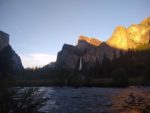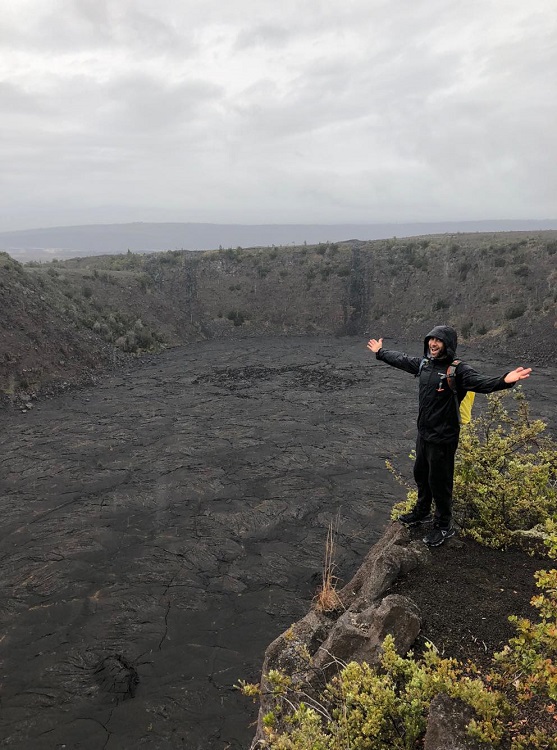Hiking The Yosemite Valley Loop Trail
Yosemite National Park is one of the busiest park’s in the entire United States. As a whole, Yosemite National Park receives over four million users through its gates every single year. The Yosemite Valley floor is one of its most visited areas in the entire park. It’s here in this valley where the sights and views have been drawing in hikers and climbers and inspiring artists and photographers since the 1800’s.
Altogether, the Yosemite Valley Loop Trail is a combined twenty miles of trails. The trail makes a loop throughout the entire valley in a east to west or vise versa fashion. Although twenty miles can seem a little daunting, most people end up only hiking a few miles at any given time. The trails are mostly flat and can be accessed from just about anywhere in Yosemite Valley. Some of the most popular portions of the trail are along the Merced River near Yosemite Falls.
Popular Views Along The Yosemite Valley Loop Trail
Hiking along the Yosemite Valley Loop Trail is a great way to take in the many views of the valley including its towering granite cliffs and thousand foot plus waterfalls. This valley trail also connects to numerous destinations and other trails. There will be the opportunity to see wildlife such as bears and deer along the path although, typically in the less crowded areas. Some of the views noticeable from the trail will include:
- El Capitan: also known as El Cap. This three thousand feet granite piece of rock is a sheer vertical cliff. It was most recently made famous in the film, Free Solo where a rock climber made it up the wall with no safety ropes in four hours.
- Half Dome: A large granite dome visible from most of the eastern half of the valley loop trail. This dome attracts visitors by the thousands each year who attempt to climb the steep dome shaped face.
- Mirror Lake: A small seasonal lake at the east end of the trail along Tenaya Lake. This area lies at the base of Half Dome and has great views of Clouds Rest, the Royal Arches, North Dome, and more.
- Bridalveil Fall: A 617 foot waterfall from the south walls of Yosemite Valley. This prominent waterfall is viewable from the western portion of the trail.
- Upper and Lower Yosemite Falls: This trail connects to the trails for both Upper and Lower Yosemite Falls. This cascading waterfall is the tallest in California and the top ten tallest in North America at well over one thousand feet.
- Most Yosemite Amenities: The Valley Loop trail does connect through the heart of Yosemite Village, the Yosemite Valley Lodge, The Yosemite Chapel The Ahwahnee Hotel, Half Dome Village, and The Visitor Center.
Cook’s Meadow and Merced River
Many of the park’s creeks, waterfalls, and streams all flow into the Merced River. The Merced runs from the high Sierra peaks and is a dividing point between the north and south portions of the valley. Each spring the snowmelt causes the Merced to flood over its banks causing lush green meadows to grow.
One of my favorite areas along this trail is near the Yosemite Valley Lodge near shuttle stop four. Here the valley trail cuts across the Merced into an area called Cook’s Meadow. Cook’s Meadow has spectacular views of of the central Yosemite Valley as well as the towering Yosemite Falls. Trails follow the Merced River here and cross a variety of well known bridges such as the Swinging Bridge and Sentinel Bridge.
On A Personal Note:
Although the entire trail is twenty miles long, not all miles need to be explored in one day. For most people and visitors alike I’d recommend the two to four miles around the area of Cook’s Meadow. This area is close to Yosemite Village. The area also gives great views of Yosemite Falls as well as the meadows around the Merced River. The portion of trail near Mirror Lake is another beautiful area that extends to the northeast area of the park. There’s a good chance of seeing wildlife through any areas along the trail. Typically the wildlife will be more common during dawn and dusk and near the edges of the valley where it’s less busy.
Do you have any updates to the hiking trail or want to share your hike/pictures? Please leave a comment below.
- Overall Difficulty: 35%
- Overall Views: 100%
Yosemite Valley Loop Trail Quick Facts:
- Elevation: 3800-4200 feet.
- Elevation Gain: 1-400 feet.
- Estimated Distance: 1-20 miles.
- My Actual Distance: 4 miles.
- Estimated Time: 1-10 hours (depending on route taken).
- My Time: 2 hours (including moving time).
Estimated distance, elevation gain, and time varies depending on route taken. Altogether the Yosemite Valley Loop Trail is about twenty miles.
Yosemite Valley Loop Trail Directions:
Yosemite Valley Loop Trail Pictures:
- Upper Yosemite Falls from Cook’s Meadow.
- Looking west towards El Capitan.
- Upper and Lower Yosemite Falls near shuttle stop number four.
- Yosemite Valley during the winter with snow atop Half Dome.
- Fall colors on a foggy morning in Cook’s Meadow.
- Mirror Lake is short lived during the spring. The area gives way to a nice beach and fall colors, however.
- From the west side of the trail during sunset looking towards Birdalveil Fall.
Who Hiking Yosemite Valley Loop Trail Is For:
Advanced Hikers: It’s hard for any hikers to not be able to admire the views along these trails. Those advanced hikers looking for more solitude will enjoy hiking away from the hotels and campgrounds. You can make the trails as long as you want or include shorter portions of the trail after doing some other short hikes in the valley.
Expert Hikers: Expert hikers might be turned off by the popularity of the valley. If you’re looking for something difficult, complete the whole loop.
It’s always a good idea to be aware of what type of hiking level you’re at.
Best Time Of Year To Hike Yosemite Valley Loop Trail:
Spring is the best time to catch the waterfalls at their best. The meadows come alive with bright green spring colors and beautiful wildflowers. Waterfalls, flowers, and greenery can still be plentiful in the early summer. Hot valley temperatures dry things out by mid-summer and by fall most waterfalls are completely gone. As fall progresses, the meadows give way to cooler temperatures and fall colors. Winter can at times bring a snowy winter playground to the valley floor.
As with any trail, it’s always a good idea to check the weather before heading out.












